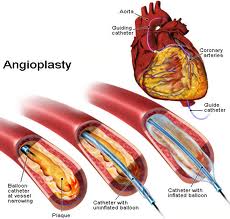Angioplasty procedure - what is, risks and outloock

What is Anginoplasty Procedure and Definition
Angioplasty is a CARDIAC CATHETERIZATION procedure to widen the opening of an ARTERY, generally as treatment for ANGINA PECTORIS, CORONARY ARTERY DISEASE (CAD), or PERIPHERAL VASCULAR DISEASE (PVD). Angioplasty is most effective when the occlusion is between 70 percent and 90 percent and affects only one or two locations within the arteries. More extensive occlusion in the coronary arteries may require CORONARY ARTERY BYPASS GRAFT (CABG) to instead redirect the blood flow through replacement arteries. The cardiovascular surgeon may also use angioplasty to remedy occlusions in arteries other than those supplying the HEART, such as to treat PVD affecting the larger arteries in the legs.
Angioplasty Procedure
Angioplasty is almost always an AMBULATORY SURGERY (same-day) procedure, or at most requires one night in the hospital for recovery and observation following the procedure. The cardiologist uses local ANESTHETIA and general SEDATION to make the person comfortable. After numbing the location with local anesthetic the cardiologist inserts a catheter into an ARTERY near the surface of the body, typically the femoral artery in the groin, and threads it into the occluded artery. Injected dye helps the cardiologist to visualize the catheter’s progress using FLUOROSCOPY (moving X-ray), which displays the images on a closed circuit monitor.
Once the catheter is in position at the occlusion, the cardiologist uses a syringe to inject a small amount of sterile solution through the catheter to inflate a tiny balloon at the catheter’s tip. The balloon applies pressure against the walls of the artery, expanding the channel through which blood flows. The cardiologist may deflate the balloon, advance the catheter, and reinflate the balloon to widen a larger segment of the artery. The procedure usually compresses accumulations of ATHEROSCLEROTIC PLAQUE (atheromas) to reduce their intrusion into the arterial passageway. The cardiologist may also use the catheter to place a STENT, a tiny springlike device that maintains pressure against the arterial wall to help maintain the widened channel in the artery at the site of the compressed atheroma.
Risks of Angioplasty and Complications
Risks during the angioplasty include HEART ATTACK or STROKE from dislodged atherosclerotic plaque (which is rare), excessive bleeding, trauma to the artery, and irritation of the heart that causes ARRHYTHMIA. The cardiac catheterization facility or hospital where the cardiologist performs the angioplasty is equipped and staffed for immediate cardiac surgery if necessary. More common complications are bleeding and PAIN at the catheter insertion site, or INFECTION following the procedure. The cardiologist may choose to administer prophylactic ANTIBIOTIC MEDICATIONS, particularly in people who are at risk for bacterial ENDOCARDITIS.
The most common complication of angioplasty is restenosis (reclosure) of the artery, either from the compressed atheroma reexpanding or from continued atherosclerotic processes that create new atheromas. About half of people who undergo angioplasty experience restenosis within two years. About a quarter have clinically significant restenosis within six months and must have a repeat angioplasty or CABG to restore blood flow to the heart. Repeat angioplasty is generally less successful, and carries a higher risk of damage to the artery. As atherosclerosis progresses, which it tends to do, other coronary arteries occlude as well.
Angioplasty Outlook and Lifestyle Modifications
Angioplasty is a temporary measure for most people, providing relief of symptoms for six months to two or three years. However, angioplasty does not treat the underlying disease process, which is likely to continue even with medical interventions such as lipid-lowering medications to slow its progress. Most arteries tend to reocclude. Some people are able to undergo multiple angioplasty procedures over time though others must look to different treatment options such as CABG. The most effective outcomes are those that follow the angioplasty with lifestyle changes to improve cardiovascular health such as WEIGHT LOSS AND WEIGHT MANAGEMENT, daily physical activity, and SMOKING CESSATION.
See also ATHERECTOMY; DIABETES AND CARDIOVASCULAR DISEASE; MEDICATIONS TO TREAT CARDIOVASCULAR DISEASE; PHYSICAL EXERCISE AND CARDIOVASCULAR HEALTH; SURGERY BENEFIT AND RISK ASSESSMENT.